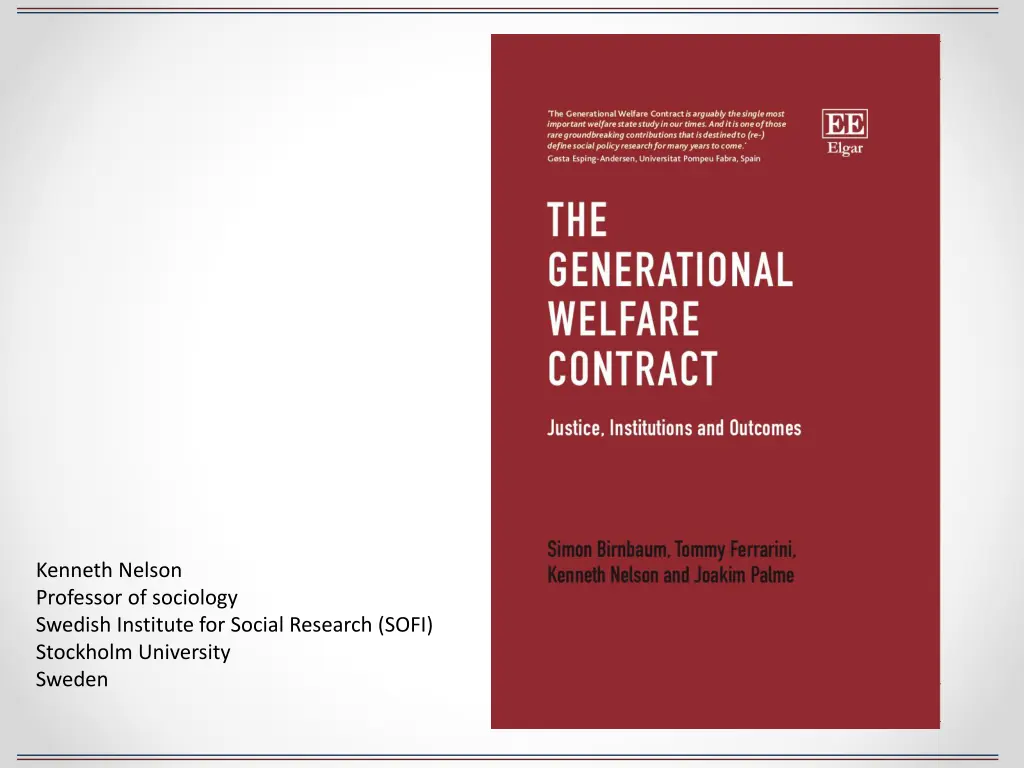
Generational Welfare Contracts in Societal Dynamics
Explore the concept of generational welfare contracts, their impact on age-related social risks, and the significance of balanced versus unbalanced configurations in promoting comprehensive social citizenship rights and positive outcomes across age groups.
Download Presentation

Please find below an Image/Link to download the presentation.
The content on the website is provided AS IS for your information and personal use only. It may not be sold, licensed, or shared on other websites without obtaining consent from the author. If you encounter any issues during the download, it is possible that the publisher has removed the file from their server.
You are allowed to download the files provided on this website for personal or commercial use, subject to the condition that they are used lawfully. All files are the property of their respective owners.
The content on the website is provided AS IS for your information and personal use only. It may not be sold, licensed, or shared on other websites without obtaining consent from the author.
E N D
Presentation Transcript
Kenneth Nelson Professor of sociology Swedish Institute for Social Research (SOFI) Stockholm University Sweden
The Generational Welfare Contract Driving forces Demographic Economic Socio-political Age-related social risks Childhood Working-age Old-age The generational welfare contract Welfare state institutional structures (social citizenship rights) Outcomes (e.g. poverty, subjective well-being, trust, employment)
Ideal-typical configurations of three unbalanced generational welfare contracts Pro-old Pro-child Pro-work
Ideal-typical configurations of the balanced generational welfare contract Pro-old Pro-child Pro-work Balanced
Ideal-typical configuration of four generational welfare contracts Pro-old Pro-child Pro-work Balanced Our basic argument in this book is that a) Balanced generational welfare contracts provide more extensive social citizenship rights for all age groups and encourage positive-sum solutions in generational politics; and b) more extensive social citizenship rights contribute positively to various outcomes that we have reason to value.
Ideal-typical configurations of four unbalanced generational welfare contracts Pro-old Pro-child Pro-work Balanced The generational welfare contract(s): income replacement in social insurance for three age-related social risks (averages for 18 OECD countries, 1980 2010) Pro-old Pro-work Balanced 100 100 100 80 80 80 60 60 60 40 40 40 20 20 20 0 0 0 The balanced contract includes Austria, Belgium, Denmark, Finland, France, Sweden and Norway. The pro-work contract includes Germany, Japan, the Netherlands and Switzerland. The pro-old contract includes Australia, Canada, Ireland, Italy, New Zealand, the United Kingdom and the United States. Source: The Social Policy Indicators Database (SPIN), own calculations.
The Belgian generational welfare contract Average 1960-2010 100 100 80 80 60 60 Childhood Working-age 40 40 Old-age 20 20 0 0 1960 1980 2010 Childhood Working age Old age Source: The Social Policy Indicators Database (SPIN), own calculations.
Balance and levels of income replacement in age-related social insurance; country-fixed effects regressions for 18 OECD countries, 1960-2010 Levels of income replacement Overall Childhood Working age Old age Balance of income replacement + + + + GDP per capita (+) (+) ( ) (+) Unemployment (+) (+) ( ) (+) Service sector employment (+) (+) (+) ( ) Old-age dependency ratio (+) (+) ( ) ( ) Civilian labor force (+) (+) ( ) (+) Parentheses indicate insignificant associations. Generational balance is measured by the inverted coefficient of variation (*100) of income replacement in age-related social insurance. The overall level is simply the average income replacement in age-related social insurance.
Social insurance and social assistance in 18 OECD countries 1990-2010. 160 120 80 40 0 0 20 40 60 80 100 Source: The Social Policy Indicators Database (SPIN), own calculations.
Contents Chapter 1: Introduction Chapter 2: Three dimensions of generational justice Chapter 3: The generational welfare contract Chapter 4: Profiling the generational welfare contract Chapter 5: Contracts against poverty Chapter 6: Contracts for life satisfaction and happiness Chapter 7: Contracts for trust Chapter 8: Contracts for or against employment? Chapter 9: Politics of generational welfare contracts Chapter 10: The generational welfare contract on the agenda
Income replacement in social insurance and poverty in three age-related risk categories by type of generational welfare contract (country averages for the period 1980 2010) Balanced Pro-work Pro-old 100 25 100 25 100 25 80 20 80 20 80 20 60 15 60 15 60 15 40 10 40 10 40 10 20 5 20 5 20 5 0 0 0 0 0 0 Income replacement in social insurance Poverty rate The balanced contract includes Austria, Belgium, Denmark, Finland, France, Sweden and Norway. The pro-work contract includes Germany, Japan, the Netherlands and Switzerland. The pro-old contract includes Australia, Canada, Ireland, Italy, New Zealand, the United Kingdom and the United States. Source: The Cross-National Data Center in Luxembourg (LIS) and the Social Policy Indicators Database (SPIN), own calculations.
Income replacement in social insurance and poverty in three age-related risk categories by type of generational welfare contract (country averages for the period 1980 2010) Balanced Pro-work Pro-old 100 25 100 25 100 25 80 20 80 20 80 20 60 15 60 15 60 15 40 10 40 10 40 10 20 5 20 5 20 5 0 0 0 0 0 0 Income replacement in social insurance Poverty rate The balanced contract includes Austria, Belgium, Denmark, Finland, France, Sweden and Norway. The pro-work contract includes Germany, Japan, the Netherlands and Switzerland. The pro-old contract includes Australia, Canada, Ireland, Italy, New Zealand, the United Kingdom and the United States. Source: The Cross-National Data Center in Luxembourg (LIS) and the Social Policy Indicators Database (SPIN), own calculations.
Pathways between balance and overall level of income replacement in age-related social insurance and poverty (EU-at-risk-of) after confounding adjustment. Country-fixed effects structural equation model of 18 OECD countries 1980 2010 Balance of income replacement Overall level of income replacement GDP per capita Poverty Service sector employment Old-age dependency ratio Negative association Positive association The model includes the following confounding factors; the unemployment rate, GDP per capita, the old-age dependency ratio, civilian labor force and service sector employment. Only statistically significant paths are shown (cluster robust standard errors).
Life satisfaction and happiness in three age-related social risk categories by generational welfare contract around 2010 (averages of 18 OECD countries) Life satisfaction Happiness 1.00 1.00 0.96 0.96 0.92 0.92 0.88 0.88 0.84 0.84 0.80 0.80 Childhood Working age Old age Childhood Working age Old age Balanced Pro-work Pro-old The balanced contract includes Austria, Belgium, Denmark, Finland, France, Sweden and Norway. The pro-work contract includes Germany, Japan, the Netherlands and Switzerland. The pro-old contract includes Australia, Canada, Ireland, Italy, New Zealand, the United Kingdom and the United States. Source: The European Social Survey and the World Values Survey.
Life satisfaction and happiness in three age-related social risk categories by generational welfare contract around 2010 (averages of 18 OECD countries) Life satisfaction Happiness 1.00 1.00 0.96 0.96 0.92 0.92 0.88 0.88 0.84 0.84 0.80 0.80 Childhood Working age Old age Childhood Working age Old age Balanced Pro-work Pro-old The balanced contract includes Austria, Belgium, Denmark, Finland, France, Sweden and Norway. The pro-work contract includes Germany, Japan, the Netherlands and Switzerland. The pro-old contract includes Australia, Canada, Ireland, Italy, New Zealand, the United Kingdom and the United States. Source: The European Social Survey and the World Values Survey.
Multilevel logistic regressions of life satisfaction and happiness on the overall level of income replacement in age-related social insurance in 18 OECD countries around 2010 Life satisfaction S:II Happiness H:I Model Individual-level variables S:I S:III H:II V1. Childhood risk category V2. Old-age risk category V3. Male V4. Couple V5. Primary education V6. Secondary education + + ( ) + + + + (+) + + (+) + + Country-level variables V7. GDP per capita V8. WVS V9. Overall level of income replacement (+) ( ) + (+) ( ) + (+) ( ) + (+) ( ) + (+) ( ) + V1*V9 V2*V9 (+) ( ) BIC 9.96 2.27 5.52
Multilevel logistic regressions of life satisfaction and happiness on the overall level of income replacement in age-related social insurance in 18 OECD countries around 2010 Life satisfaction S:II Happiness H:I Model Individual-level variables S:I S:III H:II V1. Childhood risk category V2. Old-age risk category V3. Male V4. Couple V5. Primary education V6. Secondary education + + ( ) + + + + (+) + + (+) + + Country-level variables V7. GDP per capita V8. WVS V9. Overall level of income replacement (+) ( ) + (+) ( ) + (+) ( ) + (+) ( ) + (+) ( ) + V1*V9 V2*V9 (+) ( ) BIC 9.96 2.27 5.52
Social and political trust in three age-related social risk categories by generational welfare contract in 18 OECD countries around 2010 Political trust Social trust 0.9 0.9 0.8 0.8 0.7 0.7 0.6 0.6 0.5 0.5 0.4 0.4 0.3 0.3 Childhood Working age Old age Childhood Working age Old age Balanced Pro-work Pro-old The balanced contract includes Austria, Belgium, Denmark, Finland, France, Sweden and Norway. The pro-work contract includes Germany, Japan, the Netherlands and Switzerland. The pro-old contract includes Australia, Canada, Ireland, Italy, New Zealand, the United Kingdom and the United States. Source: The European Social Survey and the World Values Survey.
Social and political trust in three age-related social risk categories by generational welfare contract in 18 OECD countries around 2010 Political trust Social trust 0.9 0.9 0.8 0.8 0.7 0.7 0.6 0.6 0.5 0.5 0.4 0.4 0.3 0.3 Childhood Working age Old age Childhood Working age Old age Balanced Pro-work Pro-old The balanced contract includes Austria, Belgium, Denmark, Finland, France, Sweden and Norway. The pro-work contract includes Germany, Japan, the Netherlands and Switzerland. The pro-old contract includes Australia, Canada, Ireland, Italy, New Zealand, the United Kingdom and the United States. Source: The European Social Survey and the World Values Survey.
Multilevel regressions of political and social trust on the overall level of income replacement in age-related social insurance in 18 OECD countries around 2010 Political trust Social trust Model P: I P: II S: I S: II Individual-level variables V1. Childhood risk category ( ) ( ) ( ) V2. Old-age risk category + (+) (+) (+) V3. Male ( ) ( ) ( ) ( ) V4. Couple ( ) ( ) + + V5. Primary education V6. Secondary education ( ) Country-level variables V7. GDP per capita (+) (+) (+) (+) V8. WVS V9. Overall level of income replacement + + + + V1*V9 (+) *p < 0.05, **p < 0.01 using cluster robust standard errors. V2*V9 ( ) BIC 7.03 5.46
Multilevel regressions of political and social trust on the overall level of income replacement in age-related social insurance in 18 OECD countries around 2010 Political trust Social trust Model P: I P: II S: I S: II Individual-level variables V1. Childhood risk category ( ) ( ) ( ) V2. Old-age risk category + (+) (+) (+) V3. Male ( ) ( ) ( ) ( ) V4. Couple ( ) ( ) + + V5. Primary education V6. Secondary education ( ) Country-level variables V7. GDP per capita (+) (+) (+) (+) V8. WVS V9. Overall level of income replacement + + + + V1*V9 (+) *p < 0.05, **p < 0.01 using cluster robust standard errors. V2*V9 ( ) BIC 7.03 5.46
Labor force participation and unemployment rates by type of generational welfare contract in 18 OECD countries 1960 2010 Labour force participation Total Male Female 100 80 100 80 80 60 60 60 40 40 40 20 20 20 0 0 0 1960 1970 1980 1990 2000 2010 1960 1970 1980 1990 2000 2010 1960 1970 1980 1990 2000 2010 Balanced Pro-work Pro-old Unemployment Total Male Female 12 12 12 10 10 10 8 8 8 6 6 6 4 4 4 2 2 2 0 0 0 1960 1970 1980 1990 2000 2010 1960 1970 1980 1990 2000 2010 1960 1970 1980 1990 2000 2010 Source: OECD.Stat.
Labor force participation and unemployment rates by type of generational welfare contract in 18 OECD countries 1960 2010 Labour force participation Total Male Female 100 80 100 80 80 60 60 60 40 40 40 20 20 20 0 0 0 1960 1970 1980 1990 2000 2010 1960 1970 1980 1990 2000 2010 1960 1970 1980 1990 2000 2010 Balanced Pro-work Pro-old Unemployment Total Male Female 12 20 14 12 10 16 10 8 12 8 6 6 8 4 4 4 2 2 0 0 0 1960 1970 1980 1990 2000 2010 1960 1970 1980 1990 2000 2010 1960 1970 1980 1990 2000 2010 Source: OECD.Stat.
Pathways between balance and overall level of income replacement in age-related social insurance and labor force participation after confounding adjustment. Country fixed effects structural equation model of 18 OECD countries 1985 2010 Balance of income replacement Employment protection legislation Overall level of income replacement Labor force participation Active labour market policy Negative association Positive association The model includes the following confounding factors; the unemployment rate, GDP per capita, the old-age dependency ratio, civilian labor force and service sector employment Only statistically significant paths are shown (cluster robust standard errors).
Generational welfare contracts and cumulative partisan cabinet shares (percentages) in 18 OECD countries 1960 2010 Cumulative partisan cabinet shares (percentages) Left Confessional 52.4 42.6 33.3 43.8 44.4 0.7 36.3 0.3 27.7 6.1 70.7 6.8 76.5 1.6 48.7 14.5 28.7 48.8 2.7 0.0 23.7 52.6 24.3 28.4 19.8 32.4 34.9 0.0 0.0 0.0 10.5 17.3 21.5 55.5 38.6 0.0 46.9 0.0 0.0 0.0 21.8 10.4 Country Austria Belgium Denmark Finland France Norway Sweden Average Germany Japan Netherlands Switzerland Average Australia Canada Ireland Italy New Zeeland United Kingdom United States Average Secular centrist/right 5.0 23.0 54.9 62.8 66.2 22.6 22.0 36.6 22.5 97.3 23.8 47.3 47.7 65.1 100.0 71.4 20.9 61.4 53.1 100.0 67.4 Contract type Balanced Pro-work Pro-old The balanced contract includes Austria, Belgium, Denmark, Finland, France, Sweden and Norway. The pro-work contract includes Germany, Japan, the Netherlands and Switzerland. The pro-old contract includes Australia, Canada, Ireland, Italy, New Zealand, the United Kingdom and the United States. Source: Korpi and Palme (2003) and the European Journal of Political Research (various years), own calculations.
Generational welfare contracts and cumulative partisan cabinet shares (percentages) in 18 OECD countries 1960 2010 Cumulative partisan cabinet shares (percentages) Left Confessional 52.4 42.6 33.3 43.8 44.4 0.7 36.3 0.3 27.7 6.1 70.7 6.8 76.5 1.6 48.7 14.5 28.7 48.8 2.7 0.0 23.7 52.6 24.3 28.4 19.8 32.4 34.9 0.0 0.0 0.0 10.5 17.3 21.5 55.5 38.6 0.0 46.9 0.0 0.0 0.0 21.8 10.4 Country Austria Belgium Denmark Finland France Norway Sweden Average Germany Japan Netherlands Switzerland Average Australia Canada Ireland Italy New Zeeland United Kingdom United States Average Secular centrist/right 5.0 23.0 54.9 62.8 66.2 22.6 22.0 36.6 22.5 97.3 23.8 47.3 47.7 65.1 100.0 71.4 20.9 61.4 53.1 100.0 67.4 Contract type Balanced Pro-work Pro-old The balanced contract includes Austria, Belgium, Denmark, Finland, France, Sweden and Norway. The pro-work contract includes Germany, Japan, the Netherlands and Switzerland. The pro-old contract includes Australia, Canada, Ireland, Italy, New Zealand, the United Kingdom and the United States. Source: Korpi and Palme (2003) and the European Journal of Political Research (various years), own calculations.
Pathways between balance and overall level of income replacement in age-related social insurance and cumulative partisan incumbency after confounding adjustment. Country fixed effects structural equation models of 18 OECD countries 1960-2010. b) 1960-2010 Left cabinet shares Balance of income replacement Overall level of income replacement Confessional cabinet shares b) 1980-2010 Balance of income replacement Overall level of income replacement Left cabinet shares Negative association Positive association The models includes the following confounding factors; the unemployment rate, GDP per capita, the old-age dependency ratio, civilian labor force and service sector employment. Only statistically significant paths are shown (cluster robust standard errors).
Conclusions Positive-sum solutions in generational politics are more likely to be supported by the balanced contract. Social citizenship rights that are generationally balanced and provide more evenly distributed protection across different stages of life are advantageous for all citizens. The balanced generational welfare contract is not only associated with increased welfare of all citizens, but inequalities are also reduced. Generational trade-offs in policymaking can thereby be reduced or even avoided, leading to more just and equal societies.





















